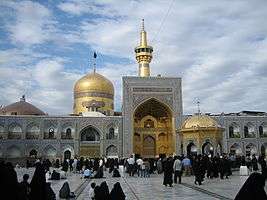Fatima Masumeh Shrine
| Fātimah Ma'sūmah Shrine | |
|---|---|
|
Shrine of Fātimah al-Ma‘sūmah, sister of ‘Alī al-Riđā | |
| Basic information | |
| Location | Qom, Iran |
| Geographic coordinates | 34°38′30″N 50°52′44″E / 34.6417°N 50.8790°ECoordinates: 34°38′30″N 50°52′44″E / 34.6417°N 50.8790°E |
| Affiliation | Shia Islam, Sunni Islam |
| Architectural description | |
| Architectural type | Mosque |
| Architectural style | Iranian |
| Specifications | |
| Dome(s) | 3 |
| Minaret(s) | 6 |
The shrine of Fatema Mæ'sume (sister of Imām ʻAlī ibn-Mūsā Riđā) is located in Qom which is considered by Shia Muslims to be the second most sacred city in Iran after Mashhad. Fatima Masumeh was the sister of the eighth Imam 'Ali al-Rida and the daughter of the seventh Imam Musa al-Kadhim (Tabari 60). In Shia Islam, women are often revered as saints if they are close relatives to one of the Twelver Imams. Fatima Masumeh is therefore honored as a saint, and her shrine in Qom is considered one of the most significant Shi'i shrines in Iran. Every year, thousands of Shi'i Muslims travel to Qom to honor Fatima Masumeh and ask her for blessings. For more information on the history of Fatima Masumeh, see Fatima bint Musa.
Also buried within the shrine are three daughters of the ninth, Twelver Shī‘ah Imām, Muhammad at-Taqī.[1]
Specifications
The mosque consists of a burial chamber, three courtyards and three large prayer halls, totalling an area of 38,000 m2 (410,000 sq ft).[2] The three prayer halls are named: Tabātabā'ī, Bālā Sar, and A‘dham.[2][3]
Visiting the Shrine
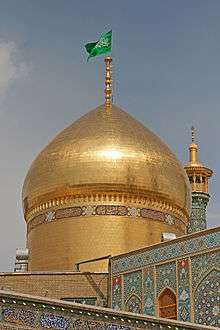
Though Shi'i theology formally states that the relatives of the Imams, or imamzadehs, hold a lower status than the Imams, popular Shi'ism still strongly venerates imamzadehs.[4] In Iran, there are many more burial places of the Imams' relatives than there are for the Imams themselves.[5] Imamzadehs are considered to be close to God and religiously pious because of their close relation to Imams.[6] Shi'is commonly travel on pilgrimages to shrines of imamzadehs, such as the Shrine of Fatima Masumeh, the sister of the 8th Imam 'Ali al-Rida, in Qom, Iran. Men and women seek cures to ailments, solutions to problems, and forgiveness of sins at these sites.[7] Many hadiths, or teachings, are recorded from Shi'i Imams praising the veneration of Fatima Masumeh, and proclaiming that those who make a pilgrimage to her Shrine will "certainly be admitted to heaven."[8]
Fatima Masumeh's Shrine in Qom is crowded every day of the year with Shi'i men, women, and children from all around the world.[9] Some stay for hours or days praying at the mosque and circumambulating her tomb. The economy of Qom has become reliant on this pilgrimage for the tourism it brings.[10] In turn, Qom has remained conservative and traditional to maintain a pious environment for pilgrims.[11] Many miracles have been recorded as taking place at this shrine, and they are documented in a special office within the shrine complex. Some are published in the shrines monthly newspaper, the Payam-e Astan.[12]
Pilgrims at the Shrine of Fatima Masumeh follow rituals that have been passed down for centuries. Imam Ali al-Rida, Fatima Masumeh's brother, outlined these ritual acts as he described the way he visited her Shrine. The prayer Imam al-Rida dictated to his sister continues to be part of the pilgrimage.[13] Since the Safavid period, additional rituals have been added that are now typical for many Shi'i pilgrimages including ritual washing beforehand, dressing in perfumed clothing, and entering the site with one's right foot.[14]
History of the Shrine
Early history
Since the beginning of Qom's history in the 7th century, the city has been associated with Shi'ism and set apart from the Sunni caliphate.[15] Many Shi'i hadiths referred to Qom as a "place of refuge for believers," calling it a deeply religious place. After Fatima Masumeh's death in Qom and the construction of her Shrine, scholars began to gather in Qom and the city gained its reputation for religious learning.[16] Today, Qom is still noted for its religious seminaries and organizations.[17]
Fatima Masumeh died in Qom in 201 A.H. as she travelled to join her brother, Imam Ali al-Rida in Khorasan.[18] The caravan she travelled in was attacked in Saveh by enemies to the Shi'i's, and 23 of Fatima Masumeh's family and friends were killed (Jaffer). Fatima Masumeh was then poisoned by a women from the enemies, fell ill, and asked to be taken to Qom, where she died.[19] Fatima Masumeh's host in Qom buried her in his plot of land.[20]
The style of Fatima Masumeh's Shrine has developed over many centuries.[21] At first, her tomb was covered with a bamboo canopy.[22] Fifty years later, this was replaced by a more durable domed building, at the request of the daughter of Imam Muhammad at-Taqī, Sayyida Zaynab.[23][24] The family of Sayyida Zainab later added a further two domes to the Shrine.[25] These architectural projects marked the beginning of female patronage of the tomb of Fatima Masumeh.
Safavid period
In 1519, Tajlu Khanum, the wife of Shah Isma'il I, led a project to improve the drainage around the Shrine, embellish the Shrine with an iwan and two minarets, and reconstruct the tomb chamber as a domed octagon.[26] During the Safavid dynasty, the women of this family were very active in embellishing the Shrine of Fatima Masumeh. In times of war, Safavid royal women found refuge in Qom, and likely compared their situation to that of Fatima Masumeh.[27] These women donated beautiful fabrics and other items to the Shrine.[28] Shah Abbas I of the Safavids did not patronize the Shrine of Fatima Masumeh as much as he did other shrines of Imams, but he did offer books to the Shrine's seminary library.[29] Over the years, many Safavids of royal birth were buried close to the Shrine of Fatima Masumeh.
Modern history
From 1795-1796, Fath-Ali Shah Qajar converted two Safavid sahn or courtyards into one large courtyard and, in 1803, fixed the golden dome.[30] In 1883, Amin al-Sultan added the new sahn e-jadid or "New Court" to the Shrine complex.[31]
In Ayatollah Khomeini's Iranian Revolution of the 1970s, Qom was named "the birthplace" of this movement. Khomeini studied in Qom and lived there at the beginning and end of the Revolution. Aspects of the culture of Qom, including the Shrine of Fatima Masumeh, were used to unite the Iranian people over significant historical and mythical events.[32] Khomeini used images of the Shrine of Fatima Masumeh in posters, money, and stamps created during the Revolution.[33] Khomeini also constructed an addition to the Shrine of Fatima Masumeh and added more space for pilgrims.[34] In addition, the tomb of Ayatollah Khomeini utilizes architectural elements that are similar to Fatima Masumeh's Shrine, such as the golden dome.[35] See Mausoleum of Khomeini.
Notable burials
Royalty
- Shah Safi (1611–1642), Shahanshah of Persia (1629–42)
- Shah Abbas II (1632–1666), Shahanshah of Persia (1642–66)
- Shah Suleiman I (1647–1694), Shahanshah of Persia (1666–94)
- Shah Sultan Hossein (1668–1726), Shahanshah of Persia (1694–1722)
- Shah Abbas III (d. 1739), Shahanshah of Persia (1732–36)
- Fath-Ali Shah (1772–1834), Shahanshah of Persia (1797–1834)
- Mohammad Shah (1808–1848), Shahanshah of Persia (1834–48)
- Mahd-e Olya (1805–1873), mother of Nasser al-Din Shah Qajar
- Kamran Mirza (1856–1927), Qajar prince and governor of Teheran
Political figures
- Manouchehr Khan Gorji Mo'tamed od-Dowleh (d. 1847), governor of Isfahan
- Farrokh Khan Amin od-Dowleh (1814–1871), Persian ambassador to France and Great Britain
- Anoushirvan Khan (Shir Khan) Qajar Qovanlou 'Eyn ol-Molk' 'Etezad od-Doleh' (-1868), khan salar, Governor-General of Mazandaran, Gorgan and Astarabad, Qazvin, Khouzestan and Mahallat, field marshall, twice great grandson of Fath Ali Shah
- Mirza Ali-Asghar Khan Amin os-Sultan (1843–1907), prime minister (1887–96) and (1907)
- Mirza Ahmad Khan Moshir os-Saltaneh (1844–1919), prime minister (1907–08)
- Mirza Hassan Khan Mostowfi ol-Mamalek (1874–1932), prime minister (1910–11, 1914–15, 1917, 1923, and 1926–27)
- Hassan Vosough (1873–1950), prime minister (1909–10, 1911, and 1916–17)
- Ahmad Qavam (1876–1955), prime minister (1921, 1922–23, 1942–43, 1946–47, and 1952)
- Hossein Dadgar Adl ol-Molk (1881–1971), speaker of the Majles (1928–35)
- Mohammad-Vali Qareni (1913–1979), army general
- Mehdi Eraqi (1930–1979), a founder of Fadayan-e Islam
- Mehdi Bazargan (1907–1995), prime minister (1979)
Scholars
- Yusef Etesami Ashtiani (1874–1938), writer and translator
- Parvin Etesami (1907–1941), poet
Clerics
- Qotbeddin Ravandi (d. 1177), medieval cleric
- Fazlollah Nuri (1843–1909), cleric
- Abdolkarim Haeri Yazdi (1859–1937), cleric
- Mohammad-Taghi Khansari (1888–1952), cleric
- Sadreddin Sadr (1882–1954), cleric
- Hossein Borujerdi (1875–1961), cleric
- Morteza Motahhari (1920–1979), cleric
- Mohammad Mofatteh (1928–1979), cleric
- Mohammad-Hosseinn Tabatabaei (1904–1981), cleric
- Ali Qoddusi (1927–1981), cleric
- Shahabeddin Mar'ashi Najafi (1897–1990), cleric
- Mohammad-Reza Golpaygani (1898–1993), cleric
- Mohammad Ali Araki (1894–1994), cleric
- Sadegh Khalkhali (1926–2003), cleric ("Eichmann of Iran")
- Mohammad-Taqi Behjat Fumani (1913–2009), cleric
- Hossein-Ali Montazeri (1922–2009), cleric
- Mohammad Montazeri (1944-1981), cleric
Gallery
| Shrine on Rial coin (1994). | |
|---|---|
 | |
| Obverse: Fatima Masumeh Shrine with name of shrine below. | Reverse: Face value, country name and Islamic year (جمهوری اسلامی ايران ۵۰ ريال ١٣٧٥). |
- Shrine of Fātimah al-Ma'sūmah, Qom
-

-
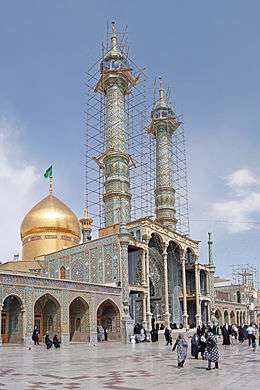
-

-

-

-
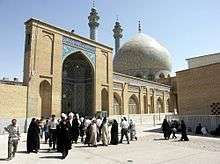
-

-

-
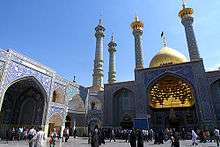
-

See also
- Holiest sites in Islam (Shia)
- Imām Ridhā Mosque
- Shāh Abdol Azīm Mosque
- Iranian architecture
- Islamic architecture
References
- ↑ "Qum, Iran". sacredsites.com. Retrieved 12 March 2009.
- 1 2 Jaffer, Masuma (2003). "3". Lady Fatima Masuma (a) of Qum Masuma Jaffer. Qom: Jami‘at al-Zahra. ISBN 964-438-455-5.
- ↑ "Today's Top StoriesQom Province". indiasnews.com. Retrieved 18 December 2006.
Shrine of Hazrat Masoumeh, sister of Imam Reza, one of Iran's holiest places, is in Qom.
- ↑ Canby, Sheila R. (2009). Shah 'Abbas: The Remaking of Iran. London: The British Museum Press.
- ↑ Canby, Sheila R. (2009). Shah 'Abbas: The Remaking of Iran. London: The British Museum Press.
- ↑ Betteridge, Anne H. (2002). "Muslim Women and Shrines in Shiraz". In Donna Lee Bowen and Evelyn A. Early. Everyday Life in the Muslim Middle East (2 ed.). Bloomington: Indiana University Press. pp. 276–289.
- ↑ Betteridge, Anne H. (2002). "Muslim Women and Shrines in Shiraz". In Donna Lee Bowen and Evelyn A. Early. Everyday Life in the Muslim Middle East (2 ed.). Bloomington: Indiana University Press. pp. 276–289.
- ↑ Jaffer, Masuma (2003). Lady Fatima Masuma (a) of Qom. Qum: Jami'at al-Zahra: Islamic Seminary for Women.
- ↑ Majd, Hooman (2008). The Ayyatolah Begs to Differ: The Paradox of Modern Iran. New York: First Anchor Books.
- ↑ Majd, Hooman (2008). The Ayyatolah Begs to Differ: The Paradox of Modern Iran. New York: First Anchor Books.
- ↑ Khosrokhavar, Farhad (2011). "Post-revolutionary Iranian youth: The case of Qom and the new culture of ambivalence". In Roksana Bahramitash and Eric Hooglund. Gender in Contemporary Iran: Pushing the boundaries. London: Routledge. pp. 99–119.
- ↑ Jaffer, Masuma (2003). Lady Fatima Masuma (a) of Qom. Qum: Jami'at al-Zahra: Islamic Seminary for Women.
- ↑ Canby, Sheila R. (2009). Shah 'Abbas: The Remaking of Iran. London: The British Museum Press.
- ↑ Canby, Sheila R. (2009). Shah 'Abbas: The Remaking of Iran. London: The British Museum Press.
- ↑ Canby, Sheila R. (2009). Shah 'Abbas: The Remaking of Iran. London: The British Museum Press.
- ↑ Jaffer, Masuma (2003). Lady Fatima Masuma (a) of Qom. Qum: Jami'at al-Zahra: Islamic Seminary for Women.
- ↑ Jaffer, Masuma (2003). Lady Fatima Masuma (a) of Qom. Qum: Jami'at al-Zahra: Islamic Seminary for Women.
- ↑ Jaffer, Masuma (2003). Lady Fatima Masuma (a) of Qom. Qum: Jami'at al-Zahra: Islamic Seminary for Women.
- ↑ Jaffer, Masuma (2003). Lady Fatima Masuma (a) of Qom. Qum: Jami'at al-Zahra: Islamic Seminary for Women.
- ↑ Canby, Sheila R. (2009). Shah 'Abbas: The Remaking of Iran. London: The British Museum Press.
- ↑ Allan, James W. (2012). The Art and Architecture of Twelver Shi'ism: Iraq, Iran, and the Indian Sub-Continent. Oxford: Azimuth Editions.
- ↑ Canby, Sheila R. (2009). Shah 'Abbas: The Remaking of Iran. London: The British Museum Press.
- ↑ Canby, Sheila R. (2009). Shah 'Abbas: The Remaking of Iran. London: The British Museum Press.
- ↑ Jaffer, Masuma (2003). Lady Fatima Masuma (a) of Qom. Qum: Jami'at al-Zahra: Islamic Seminary for Women.
- ↑ Canby, Sheila R. (2009). Shah 'Abbas: The Remaking of Iran. London: The British Museum Press.
- ↑ Canby, Sheila R. (2009). Shah 'Abbas: The Remaking of Iran. London: The British Museum Press.
- ↑ Canby, Sheila R. (2009). Shah 'Abbas: The Remaking of Iran. London: The British Museum Press.
- ↑ Canby, Sheila R. (2009). Shah 'Abbas: The Remaking of Iran. London: The British Museum Press.
- ↑ Canby, Sheila R. (2009). Shah 'Abbas: The Remaking of Iran. London: The British Museum Press.
- ↑ Allan, James W. (2012). The Art and Architecture of Twelver Shi'ism: Iraq, Iran, and the Indian Sub-Continent. Oxford: Azimuth Editions.
- ↑ Allan, James W. (2012). The Art and Architecture of Twelver Shi'ism: Iraq, Iran, and the Indian Sub-Continent. Oxford: Azimuth Editions.
- ↑ Rivzi, Kishwar (2003). "Religious Icon and National Symbol: The Tomb of Ayatollah Khomeini in Iran". Muqarnas. 20: 209–224. doi:10.1163/22118993-90000045.
- ↑ Allan, James W. (2012). The Art and Architecture of Twelver Shi'ism: Iraq, Iran, and the Indian Sub-Continent. Oxford: Azimuth Editions.
- ↑ Jaffer, Masuma (2003). Lady Fatima Masuma (a) of Qom. Qum: Jami'at al-Zahra: Islamic Seminary for Women.
- ↑ Allan, James W. (2012). The Art and Architecture of Twelver Shi'ism: Iraq, Iran, and the Indian Sub-Continent. Oxford: Azimuth Editions.
External links
| Wikimedia Commons has media related to Fatimah Ma'sumah Shrine. |

